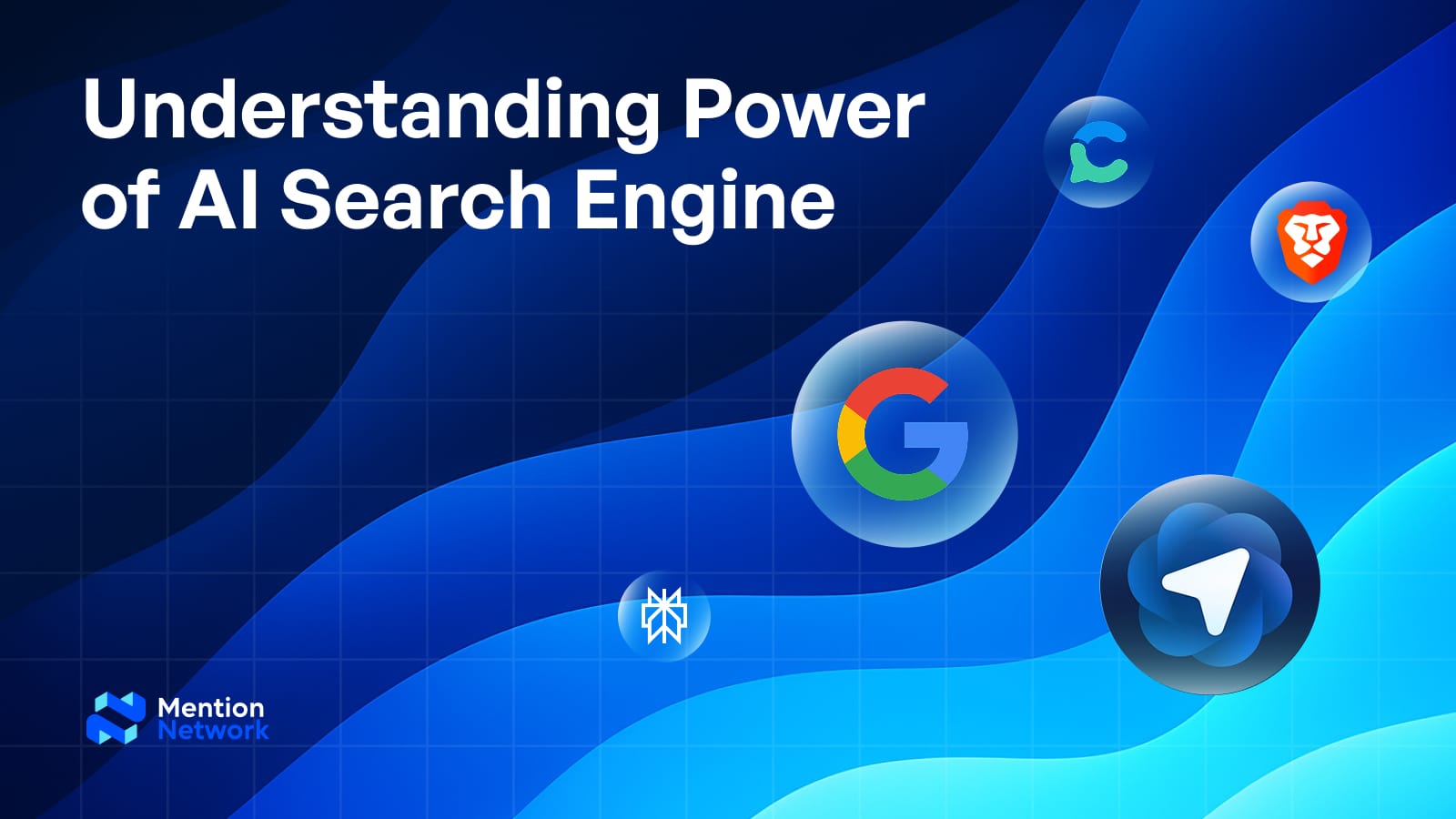Understanding Power of AI Search Engine

AI Search Engine is not a subtle algorithmic tweak, it is a fundamental shift from a system of indexing to a system of understanding. Powered by advanced artificial intelligence, this new generation of search technology doesn't just match keywords, it comprehends the context, intent, and semantics of your query, synthesizing knowledge into direct, conversational, and highly personalized responses.
- Shifts from Links to Answers: AI search engines prioritize delivering a direct, synthesized answer rather than a list of links, driving the "zero-click" phenomenon.
- Context and Intent are Paramount: They utilize advanced Natural Language Processing (NLP) and Large Language Models (LLMs) to understand why a user is searching, not just what keywords they typed.
- Semantic Search is the Foundation: Core technologies like vector embeddings and semantic matching enable the engine to find results based on conceptual meaning, not just exact word matching.
- The Rise of Conversational Discovery: Users can engage in natural, multi-turn dialogues with the search engine, blurring the lines between a traditional search box and an intelligent assistant.
- New SEO Imperatives: Success now hinges on creating high-quality, authoritative, well-structured, and machine-readable content that an AI can trust and cite.
- Personalization at Scale: AI engines leverage individual user history, location, and real-time data to create highly tailored search experiences, making every user's result unique.
What Exactly is an AI Search Engine? (And How is it Different?)
An AI search engine is a sophisticated information retrieval system that leverages artificial intelligence technologies, primarily Large Language Models (LLMs), Machine Learning (ML), and Natural Language Processing (NLP) to move beyond simple keyword matching and deliver direct, context-aware, and synthesized answers.
Traditional search engines excelled at matching a query to an index of documents based on keyword frequency, link authority, and other established ranking signals. They were excellent librarians, providing you with a list of books that might contain the answer. The burden of synthesizing the final answer rested entirely on the user, who had to click through several links.
The AI search engine flips this model. It acts as a brilliant researcher. When you submit a query, the AI interprets the meaning, generates dozens of related sub-queries to explore every facet of the intent, analyzes multiple web sources, and then uses a generative model to synthesize a single, comprehensive, and conversational answer. Tools like Google’s Gemini-powered Search Generative Experience (SGE) or Perplexity are the most prominent examples of this seismic shift.
Why It Matters: The Efficiency & Expectation Gap
This difference represents an immediate and massive shift in user behavior. Users are increasingly coming to expect instant, accurate answers without having to sift through a Search Engine Results Page (SERP). This acceleration of the information retrieval process has a direct impact on traffic patterns, content strategy, and the very economics of digital visibility. If a user receives a satisfactory, zero-click answer, your website has lost a potential visit making the goal not just to rank, but to be the source that the AI cites.
The Core Technology: How AI Deciphers User Intent
The superior performance of AI search engines is rooted in advanced computational methods specifically semantic search powered by vector embeddings that allow the system to understand the conceptual relationship between words and ideas, transcending the limits of lexical (keyword) matching.
The Vectorization of Knowledge
At the heart of an effective AI search engine lies the concept of vector embeddings. Think of a vector as a mathematical coordinate for an idea or word. The AI converts every piece of indexed data a paragraph, an image, a video transcript into a dense, multi-dimensional numerical array, or vector. The magic is this: vectors representing concepts that are semantically similar (e.g., "apple smartphone" and "iPhone") are placed closer together in this mathematical space than those that are conceptually different (e.g., "apple fruit").
When a user submits a query, it is also converted into a vector. The AI then uses sophisticated nearest-neighbor algorithms to quickly find the closest-matching document vectors, regardless of the exact keywords used. This is why you can ask a complex, natural language question and receive a highly relevant result, even if the content doesn't contain a single exact match of your query terms.
- Natural Language Processing (NLP) for Nuance: NLP analyzes the entire sentence, not just individual words, to grasp the context. This allows the AI to differentiate between a search for "Apple stock price" and "apple pie recipe."
- Machine Learning (ML) for Continuous Improvement: ML algorithms continuously learn from these patterns, refining the ranking and synthesis models to deliver increasingly precise, personalized, and authoritative responses over time.
Traditional Search vs. AI Search: A New Battleground for Visibility
The crucial distinction between traditional and AI search lies in their primary output: the former provides a list of links for the user to research, while the latter provides a synthesized answer that often minimizes the need to click away from the search interface.
The transition from a link-based search to an answer-based search has monumental implications across the digital ecosystem, particularly for those focused on traffic acquisition and conversion.
For developers, this means the need to integrate with conversational APIs and vector databases is growing rapidly. For founders and investors, it suggests a strategic pivot away from high-volume, low-intent traffic models toward a focus on deep-authority content that an AI will select as a reliable source.
Adapting Your Strategy for the Intelligent Web
Marketing and content professionals must pivot from an optimization strategy centered on ranking for keywords to one focused on building trust and authority that makes content highly citable by an AI.
The rules of engagement for digital visibility are being rewritten by the AI search engine. To succeed, your content must satisfy two audiences simultaneously: the human user and the AI model that intermediates the search.
The New Pillars of GEO Optimization
- Embrace Content Authority (E-E-A-T): AI systems are heavily weighted toward sources that demonstrate Experience, Expertise, Authoritativeness, and Trustworthiness. This means content must be authored by verifiable experts, grounded in data, and kept meticulously up-to-date. If the AI doesn't trust your source, it won't cite it in a generative answer.
- Focus on Topic Depth, Not Keyword Density: AI understands entire topics and concepts. Instead of aiming for 10 distinct articles covering slightly different keywords, create one comprehensive, pillar piece that answers every facet of a user’s need (a “reasoning chain”). This holistic approach signals deep expertise to the AI.
- Structure for Synthesis: Content must be hyper-scannable and machine-readable. Use clear, nested headings (H2, H3, H4), definitional paragraphs, bulleted lists, and tables. These formats are easy for an AI to parse, extract, and synthesize into a direct answer without losing context.
- Prioritize Semantic Optimization with Structured Data: Implement structured data (Schema Markup) religiously. This explicitly tells the AI what your content is about whether it's an FAQ, a product, or a how-to guide allowing the engine to categorize and retrieve it with greater accuracy.
How it Works: The Citation Loop
An AI search engine’s response often includes "citations" or links to the sources used to generate the answer. The new SEO goal is to be selected for this crucial citation. While a citation may not always drive a click, it establishes your brand as the trusted voice on a topic, which is a powerful asset in a trust-centric search environment.
The Future is Agentic: AI Search Beyond the Current Horizon
The evolution of the AI search engine is leading toward an "agentic" future, where AI assistants will not only answer questions but proactively complete complex, multi-step tasks on the user's behalf, fundamentally changing the customer journey.
The current generation of AI search is already impressive, but it is merely the foundation for what's next. We are moving toward a world where AI will be an agent for the user. Imagine asking your search engine: "Plan a weekend trip to Chicago for my family, including hotel booking and finding tickets for a kid-friendly museum, all under a $1,500 budget."
An agentic AI search engine will:
- Deconstruct the Task: Break the query into sub-tasks (Find hotel, calculate budget, search for museum, compare prices).
- Execute Transactions: Interact directly with APIs from hotels, airlines, and ticketing platforms.
- Synthesize the Outcome: Present a fully orchestrated itinerary with pre-filled booking forms, all without the user ever having to visit the individual vendor websites.
The customer journey will increasingly be mediated by AI agents. Businesses must prepare by creating technical infrastructure robust APIs, excellent data structuring, and a focus on canonical, transactional content to allow these agents to interact and transact seamlessly with their platform. The old conversion funnel that relied on search engine traffic is being replaced by an "experience flywheel" optimized for AI-driven interaction.
The End of an Era, The Beginning of Intelligence
The transition to the AI search engine marks a definitive end to the digital age defined by static keyword matching. We are now firmly in the era of contextual intelligence. This shift is an immense challenge to the status quo, forcing a necessary re-evaluation of digital investment, content strategy, and technological infrastructure.
For those willing to adapt the forward-thinking marketers who build for authority, the developers who embrace vector databases, and the founders who prioritize machine-readability the AI search engine offers not a threat, but a profound opportunity. It is a chance to move beyond the shallow game of keyword ranking and compete on the merit of genuine expertise and high-quality data. The future of search is here, and it’s intelligent, conversational, and ready to reward those who truly understand the depth of their user's intent.
FAQ: Quick Answers on AI Search Engines
What is the main technology that powers an AI search engine?
The main technologies are Large Language Models (LLMs) like Google's Gemini or OpenAI's GPT-4, Natural Language Processing (NLP) for understanding conversational queries, and Vector Embeddings which enable semantic search by representing information as mathematical concepts.
What is a zero-click search?
A zero-click search is a query where the user receives the complete, satisfying answer directly on the Search Engine Results Page (SERP) via an AI-generated summary, eliminating the need to click on any external links.
How will AI search affect your website traffic?
High-value, authoritative, and transactional content that is cited by the AI may see increased quality traffic, as the user clicks through for deeper detail or to complete a purchase. The goal shifts from quantity to quality of traffic.
Do I still need to do SEO?
Yes. The focus moves from technical SEO and keyword density to building verifiable authority (E-E-A-T), structuring content with schema markup, and ensuring your information is the most trustworthy source the AI can find.
Is an AI search engine the same as a chatbot?
No. While both use LLMs and are conversational, an AI search engine has real-time, broad access to the indexed web to provide current and cited information. A chatbot typically only uses its pre-trained, static dataset.

